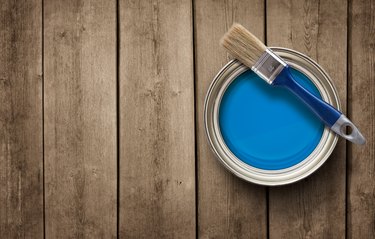Paint projects are popular and a particularly easy do-it-yourself skill. Prolific painters who parlay old furniture into new works of art or turn canvases into multi-material masterpieces often find the need to thin paint to make it perform properly. Paint is usually the final coat to a project, so you should ensure that it is the correct viscosity and won't goop or gunk up a piece or place you've worked hard on.

Video of the Day
When to Thin
There are a few ways to test to see if your paint is too thick. If it comes off in globs after you've stirred it, you need a bit of thinner. If you aren't sure, pour some of your paint through the funnel. If it gets stuck or trickles out, it needs some thinner added. For a large amount, use as large container, such as a 5-gallon bucket for 1-gallon of paint, so that you aren't thinning multiple times and getting inconsistent results. This gives you plenty of room to add thinner and mix without slopping over the sides.
Video of the Day
Latex Paint Thinning Process
If your latex is lumpy, water can make it silky and ready to be soaked into your chosen material. Adding a half a gallon of water at room temperature to 1 gallon of latex paint will thin out your mixture. Add it slowly until you get to the right viscosity. This brings old paint back to its former luster, which is better for smaller projects. Thinning old latex paint for large projects may give you an inconsistent coat as you roll the paint onto your wall or project. For very small projects, add 1/2 cup of water to 1 cup of latex paint and stir it with a brush in a container that is at least 3 cups. This way you have room to rub the mixture into the correct consistency.
Oil Paint Thinning Process
Oil-based paints need a bit more care when thinning. Grab some gloves and use containers you either don't mind throwing out or can dedicate for future oil paint projects. If you are susceptible to strong smells, a face mask might be helpful as well. Remove any big chunks of dried paint from the can before pouring what you hope to salvage into the large container for mixing. For every 3 parts of paint, add 1 part of mineral spirits or turpentine little by little. Stir with a paint stick or large yard stick that you will discard. Test it by brushing it onto a small surface of the same substance you will eventually be painting it onto. Add more turpentine or mineral spirits a little at a time until you get the consistency you prefer.